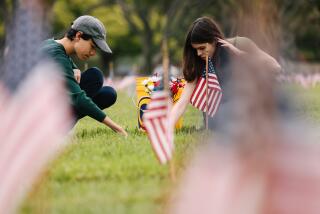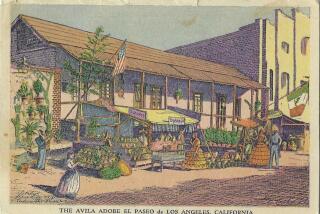Families of Hero St. Live Up to the Name
SILVIS, Ill. — For more than 40 years, scores of Mexican-Americans have gone off to war from a winding drive of tiny wood-frame houses perched on a hillside rising from an old rail yard in this Illinois town.
Eight have returned in caskets.
And since 1968, the street has been named Hero Street U.S.A. in honor of the 110 young warriors who have left it for the armed forces since 1941. Now a move is under way to get Congress to name the former dirt path a national monument.
For Joe Munos and his family, life on Hero Street always meant serving their country. Not only did Munos and his three brothers all fight for the United States--his brother Johnny died in Korea--but his three sons, daughter and grandson joined the armed forces.
“That’s the tradition of Hero Street,” Munos said. “It must be in our blood. It’s an honor for me to be a veteran of foreign wars.”
For Georgia Sandoval Herrera, growing up on Hero Street meant watching half a dozen brothers leave during World War II and seeing two return in caskets. Brothers Joe and Frank died 10 months apart, and portraits of them in uniform still hang on her living room wall.
“It seemed like a ghost town during the war because so many of our boys were gone,” she said. “But we were one big family on Hero Street. The losses pulled us together. We’re still a very close community.
“My son says, ‘Why don’t we move?’ And I say the only place I’d want to live is Hero Street. There’s no place like Hero Street.”
Another Sandoval family sent seven boys into World War II and suffered one death.
Those kinds of statistics are common on Hero Street.
No other single block in the United States has made so great a sacrifice, according to local officials. Although the Defense Department can’t confirm the claim, it’s never been disputed in 20 years.
A memorial park was built on the site in 1971, and now a city alderman is leading the drive to have Congress declare Hero Street a national monument as a tribute to all who died in service--especially immigrant soldiers.
“These men walked into this country and picked up arms without a complaint,” Alderman Joe Terronez said. “Some weren’t even citizens when they joined the armed forces. This is a great story about great heroes, and it should be a national monument.”
Located between Billy Goat Bluff and Honey Creek, Hero Street is a small Mexican barrio that winds its way back up a dead-end hollow near the rail yard in this town of 7,200.
Some of its 36 tiny bungalows sit precariously on the steep terrace of the bluff, while others are perched just above the creek and appear to be sinking into the gully.
Many of the wood-frame homes are long and narrow, like the railroad boxcars they replaced. Until a few years ago, the street was a dirt path that turned to mud and trapped hearses as they brought home dead soldiers.
When Terronez was growing up, Hero Street was simply 2nd Street and a “tough neighborhood.” Living conditions were poor for the large Mexican families crowded into the cramped houses.
The Mexicans were brought to Silvis early this century by the railroads as cheap labor. Originally, they lived in boxcars in the nearby rail yard but were moved to 2nd Street when townspeople complained about the growing Mexican population in the yard.
“This is a story of our parents coming to the United States and adopting it,” Terronez said. “Although we were all viewed as aliens, the boys of Hero Street proved this was their country.”
The fight for national monument status is more than just a battle for recognition of the contribution made by eight dead soldiers or even 110 men and women who joined the armed forces.
For Terronez, it epitomizes the struggle of Hispanic Americans everywhere for appreciation and respect as first-class citizens.
Hero Street’s residents hope for tangible benefits from elevating the street to a national monument.
More to Read
Sign up for Essential California
The most important California stories and recommendations in your inbox every morning.
You may occasionally receive promotional content from the Los Angeles Times.










